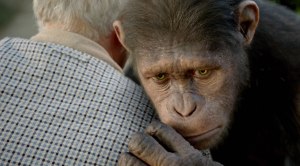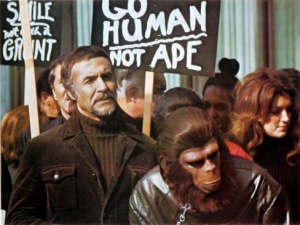It was just last year in mid-December before I could claim that I had seen all 28 Godzilla films. Okay, 29 films if we count that flick released in 1998. It was a journey dating back to a Sunday afternoon in the mid-70s when I first watched King Kong vs. Godzilla. There were highs and lows but I enjoyed every minute of it. This past May, Godzilla returned to the big screen for his official 30th film during the 60th anniversary of the franchise. At the time, this blogger was taking a break. But I was still going to the movies and I was there opening weekend. So, my series on Godzilla isn’t complete until I offer up my thoughts on the latest film.
First, I’ll get it out of the way…I liked it. Godzilla (2014) is not my favorite film of the franchise but nor is it my least favorite. It has plenty of good going for it but there are some glaring negatives that can’t be ignored. Director Gareth Edwards had previously given us Monsters (2010), a very fun film that I highly recommend. So, he knows how to put together a monster movie. The movie does play around with the origin of Godzilla but I’m okay with that. It handles it in a way that is okay and really didn’t bother me like I know it did some people.
Our movie starts out in 1954 and we witness a secret nuclear test. A bomb with a monster symbol on it is launched just as we see what appears to be a giant creature emerging from the sea. Then, we flash forward to 1999 where scientists are investigating a giant skeleton in a Philippian mine. Next to it are two giant eggs, one unhatched while the other is broken. It appears that one has escaped the mine. Meanwhile, in Japan, a nuclear power plant is investigating strange seismic activity. Joe Brody (Bryan Cranston, Breaking Bad) sends his wife Sandra into the reactor to investigate. Suddenly, the reactor is breached and radioactivity is released, killing Sandra and the other technicians. Everyone is evacuated as the plant begins to melt down and explode.
 Fifteen years later, Joe is a mental and emotional wreck, hell bent on proving something was behind the plant disaster. His son Ford (Aaron Taylor-Johnson, Kick-Ass) is now in the Navy and growing weary of bailing his estranged father out of jail. Joe knows there is a cover-up and returns to Japan for answers. There, he and his son discover the plant is active again just before getting arrested. Their timing coincides with another incident as a giant winged creature attacks the plant, ultimately killing Joe. The creature is classified as a MUTO (Massive Unidentified Terrestrial Organism) and Ford finds himself in the center of a mission to destroy it. It turns out this is one of two from the eggs in the Philippian mine. This triggers the return of Godzilla, who we discover was the monster the military tried to kill in 1954 (a homage to the events of the first and original film). With the monsters set to clash and the military desperate to save everyone, our battleground is set.
Fifteen years later, Joe is a mental and emotional wreck, hell bent on proving something was behind the plant disaster. His son Ford (Aaron Taylor-Johnson, Kick-Ass) is now in the Navy and growing weary of bailing his estranged father out of jail. Joe knows there is a cover-up and returns to Japan for answers. There, he and his son discover the plant is active again just before getting arrested. Their timing coincides with another incident as a giant winged creature attacks the plant, ultimately killing Joe. The creature is classified as a MUTO (Massive Unidentified Terrestrial Organism) and Ford finds himself in the center of a mission to destroy it. It turns out this is one of two from the eggs in the Philippian mine. This triggers the return of Godzilla, who we discover was the monster the military tried to kill in 1954 (a homage to the events of the first and original film). With the monsters set to clash and the military desperate to save everyone, our battleground is set.
Godzilla offers up some great battle sequences. The scene where Godzilla first breathes fire is iconic. The MUTO does closely resemble the Cloverfield monster but, that aside, it is a great design. While the new design for Godzilla is not my favorite (yes, I agree his head is too small), he is still better than some of the goofier and more campy designs we’ve seen before. So, again, not the best but not the worst. I do like how we have a slow build-up to Godzilla’s arrival on screen. However, it would have been nice to see more of the battles and a little less of Ford’s character. His wife, Ellie (Elizabeth Olson, Avengers: Age of Ultron) also didn’t serve much of a purpose. Who I wanted to see more of was Joe and Dr. Ishiro Serizawa (Ken Watanabe, Inception). His line, “Let them fight”, really symbolized what many people wanted.
 While I agree that we needed more Godzilla in this movie, I disagree with many fans who disliked the movie. As I stated earlier, I enjoyed it. Yes, it could have been better but let’s not forget 1998. It could have been much worse. It was a box office success and a sequel has been announced for June 8, 2018. With the announcement from Gareth Edwards that Legendary Pictures has licensed Mothra, Rodan and King Ghidorah from Toho Pictures, it is leaving many of us Godzilla fans hopeful that the sequel will offer up more of what we really want to see.
While I agree that we needed more Godzilla in this movie, I disagree with many fans who disliked the movie. As I stated earlier, I enjoyed it. Yes, it could have been better but let’s not forget 1998. It could have been much worse. It was a box office success and a sequel has been announced for June 8, 2018. With the announcement from Gareth Edwards that Legendary Pictures has licensed Mothra, Rodan and King Ghidorah from Toho Pictures, it is leaving many of us Godzilla fans hopeful that the sequel will offer up more of what we really want to see.
Godzilla is definitely worth checking out. Watch the trailer now and buy the movie to add to your collection when it is released on September 16.
































